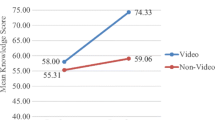Abstract
The purpose of this study was to understand and compare patient and staff perceptions of a video-based preparatory education tool for head and neck radiotherapy. Patients and staff completed a questionnaire assessing their perceptions of whether the education tool was relevant, clear, complete and reassuring. Staff rated the video's accuracy and anticipated impact on future patient information needs. Demographic information was collected. Open-ended questions were used to elicit additional feedback. Quantitative responses from 50 patients and 48 staff were very positive and not significantly different between the two groups. Content analysis of the qualitative data provided insight into the information and approaches valued by patients and staff and how these differed. Staff members were more critical of the production quality and completeness of information related to procedures and treatment side effects. Patients valued seeing procedures acted out and desired more information about what these experiences would feel like and how to engage in self-care. Although staff-driven development may be an effective method of designing the content and approach of a preparatory education video, care should be taken to consider differences between patient and staff perceptions of information needs.

Similar content being viewed by others
References
Bolderston A (2008) Mixed messages? A comparison between the perception of radiation therapy patients and radiation therapists regarding patient's educational needs. Radiography 14(2):111–119
Carey M, Schofield P, Jefford M, Krishnasamy M, Aranda S (2007) The development of audio-visual materials to prepare patients for medical procedures: an oncology application. Eur J Cancer Care (Engl) 16(5):417–423. doi:10.1111/j.1365-2354.2006.00772.x
Chan RJ, Webster J, Marquart L (2012) A systematic review: the effects of orientation programs for cancer patients and their family/carers. Int J Nurs Stud. doi:10.1016/j.ijnurstu.2012.03.002
Dunn J, Steginga SK, Rose P, Scott J, Allison R (2004) Evaluating patient education materials about radiation therapy. Patient Educ Couns 52(3):325–332. doi:10.1016/S0738-3991(03)00108-3S0738399103001083
Fredericks S, Guruge S, Sidani S, Wan T (2009) Patient demographics and learning needs: examination of relationship. Clin Nurs Res 18(4):307–322
Geinitz H, Marten-Mittag B, Schafer C, Henrich G, Bittner I, Herschbach P, Dinkel A, Sehlen S (2012) Patient satisfaction during radiation therapy. Correlates and patient suggestions. Strahlenther Onkol 188(6):492–498. doi:10.1007/s00066-011-0056-1
Gysels M, Higginson IJ (2007) Interactive technologies and videotapes for patient education in cancer care: systematic review and meta-analysis of randomised trials. Support Care Cancer 15(1):7–20. doi:10.1007/s00520-006-0112-z
Hahn CA, Fish LJ, Dunn RH, Halperin EC (2005) Prospective trial of a video educational tool for radiation oncology patients. Am J Clin Oncol 28(6):609–612
Halkett GK, Kristjanson LJ (2007) Patients' perspectives on the role of radiation therapists. Patient Educ Couns 69(1–3):76–83
Houts PS, Doak CC, Doak LG, Loscalzo MJ (2006) The role of pictures in improving health communication: a review of research on attention, comprehension, recall, and adherence. Patient Educ Couns 61(2):173–190. doi:10.1016/j.pec.2005.05.004
Keulers BJ, Welters CF, Spauwen PH, Houpt P (2007) Can face-to-face patient education be replaced by computer-based patient education? A randomised trial. Patient Educ Couns 67(1–2):176–182. doi:10.1016/j.pec.2007.03.012
Krouse HJ (2001) Video modelling to educate patients. J Adv Nurs 33(6):748–757
Leydon GM, Boulton M, Moynihan C, Jones A, Mossman J, Boudioni M, McPherson K (2000) Cancer patients' information needs and information seeking behaviour: in depth interview study. BMJ 320(7239):909–913
Llewellyn CD, McGurk M, Weinman J (2006) How satisfied are head and neck cancer (HNC) patients with the information they receive pre-treatment? Results from the satisfaction with cancer information profile (SCIP). Oral Oncol 42(7):726–734. doi:10.1016/j.oraloncology.2005.11.013
Ness S (2012) Making the case for health literacy. J Cancer Educ. doi:10.1007/s13187-012-0390-8
Neuhauser L, Kreps GL (2008) Online cancer communication: meeting the literacy, cultural and linguistic needs of diverse audiences. Patient Educ Couns 71(3):365–377. doi:10.1016/j.pec.2008.02.015
Pacut A (1987) How to use the Mann–Whitney test to detect a change in distribution for groups. Acta Neurobiol Exp (Wars) 47(1):19–26
Poroch D (1995) The effect of preparatory patient education on the anxiety and satisfaction of cancer patients receiving radiation therapy. Cancer Nurs 18(3):206–214
Rainey LC (1985) Effects of preparatory patient education for radiation oncology patients. Cancer 56(5):1056–1061
Rattray J, Jones MC (2007) Essential elements of questionnaire design and development. J Clin Nurs 16(2):234–243. doi:10.1111/j.1365-2702.2006.01573.x
Rutten LJ, Arora NK, Bakos AD, Aziz N, Rowland J (2005) Information needs and sources of information among cancer patients: a systematic review of research (1980–2003). Patient Educ Couns 57(3):250–261. doi:10.1016/j.pec.2004.06.006
Sandelowski M (2000) Whatever happened to qualitative description? Res Nurs Health 23(4):334–340. doi:10.1002/1098-240X(200008)23:4<334::AID-NUR9>3.0.CO;2-G
Schofield P, Jefford M, Carey M, Thomson K, Evans M, Baravelli C, Aranda S (2008) Preparing patients for threatening medical treatments: effects of a chemotherapy educational DVD on anxiety, unmet needs, and self-efficacy. Support Care Cancer 16(1):37–45. doi:10.1007/s00520-007-0273-4
Thomas R, Daly M, Perryman B, Stockton D (2000) Forewarned is forearmed—benefits of preparatory information on video cassette for patients receiving chemotherapy or radiotherapy—a randomised controlled trial. Eur J Cancer 36(12):1536–1543
Ziegler L, Newell R, Stafford N, Lewin R (2004) A literature review of head and neck cancer patients information needs, experiences and views regarding decision-making. Eur J Cancer Care (Engl) 13(2):119–126. doi:10.1111/j.1365-2354.2004.00449.x
Acknowledgments
The authors wish to thank Graham Wilson, Brian O'Sullivan, Kristin Foster and Nazek Abdelmutti for their substantial work in assisting with production of the education materials. We also wish to acknowledge the patients who appeared in the videos and the head and neck site group staff for their input. The authors confirm that there are no potential or actual conflicts of interest for this work.
Conflict of Interest
There are no sources of funding to declare. The authors declare that they have no conflict of interest.
Author information
Authors and Affiliations
Corresponding author
Rights and permissions
About this article
Cite this article
Morley, L., McAndrew, A., Tse, K. et al. Patient and Staff Assessment of an Audiovisual Education Tool for Head and Neck Radiation Therapy. J Canc Educ 28, 474–480 (2013). https://doi.org/10.1007/s13187-013-0489-6
Published:
Issue Date:
DOI: https://doi.org/10.1007/s13187-013-0489-6




